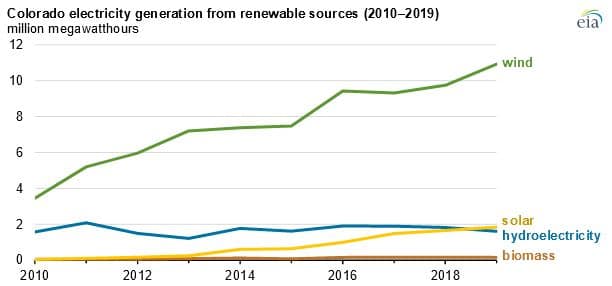Colorado’s Wind Generation More Than Tripled Over the Last Decade: EIA

Renewables’ share of Colorado’s electricity generation grew from 10 percent to 25 percent between 2010 and 2019, according to a July 23 report from the U.S. Energy Information Administration. Wind generation more than tripled since 2010, providing nearly 20 percent of the state’s electricity generation in 2019.
Renewable electricity generation increased by more than double from 5.1 million megawatt hours in 2010 to 13.9 million megawatt hours in 2019. Wind has been the main source of new renewable electricity generation and solar, surpassing hydroelectric power, has become the second largest renewable energy source.
Colorado ranked seventh among the top 10 energy-producing states in the country in 2018. The growth of energy production in the state since 2010 has largely resulted from the increased production of fossil fuels, especially natural gas and crude oil. Renewable-sourced electricity generation has increased, while coal production has declined.
In 2019, the state’s natural gas gross withdrawals reached 5.5 million cubic feet per day, ranking the eighth-highest in the country. Most natural gas is produced in five counties, according to the Colorado Oil and Gas Conservation Commission: Weld County, which is north of Denver, accounted for nearly 50 percent of the state’s total natural gas production in 2019. Garfield, La Plata, Mesa, and Rio Blanco counties in the western part of the state accounted for almost 44 percent of the production last year.
Colorado’s crude oil production rose by more than five times from 2009-2019. The rise in production is primarily attributed to increased horizontal drilling and hydraulic fracturing. The state ranked the fifth-largest in crude oil production, accounting for nearly 4 percent of the country’s total production.
Coal production has declined in the state, from its peak of 36 million short tons in 2007 to 12.5 million short tons in 2019 as a result of the boom in natural gas and renewables. In 2010, coal contributed to 68 percent of the power generation, while in 2019, this number has fallen to 45 percent.
EnerKnol Pulses like this one are powered by the EnerKnol Platform—the first comprehensive database for real-time energy policy tracking. Sign up for a free trial below for access to key regulatory data and deep industry insights across the energy spectrum.
ACCESS FREE TRIAL